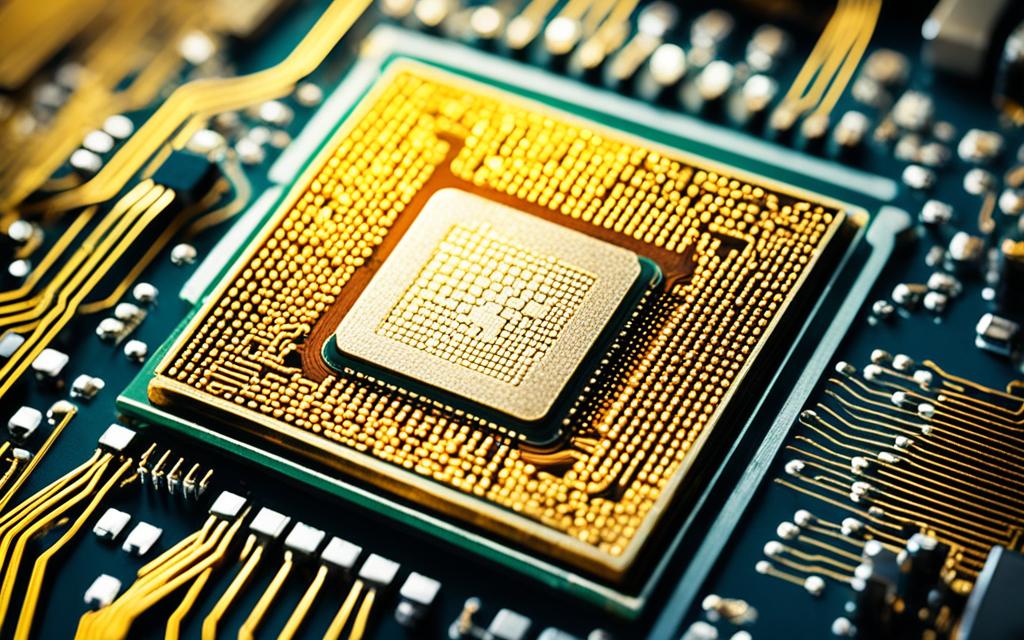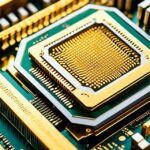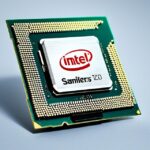Table of Contents
The fascination with the amount of gold in a CPU is growing, especially with the boom in electronics recycling. CPUs, the heart of our computers, hold not just essential data but also precious gold. You’d find about 0.2 grams or 0.007 ounces of gold in a desktop computer’s CPU and memory chips1. Knowing the CPU gold content is important. It shows us the value hidden in old electronics and the benefit of gold recovery. This helps deal with the mounting problem of electronic waste. Let’s look into the typical gold content in CPUs and the importance of recycling it.
Key Takeaways
- CPUs contain valuable gold that can be recovered during recycling.
- A desktop computer typically has around 0.2 grams of gold.
- Recycling e-waste is essential due to the significant global volume.
- Gold extracted from CPUs can be economically viable on a large scale.
- Only 12.5% of e-waste is recycled or reprocessed globally.
- Gold’s conductivity and resistance to corrosion contribute significantly to its value in electronics.
Understanding the Role of Gold in Electronics
Gold plays a crucial role in electronics due to its unique traits. These traits boost the functionality and reliability of devices. It’s key for the performance of electronic components in today’s technology.
The Importance of Gold in Electronics
The electronics sector highly values gold for its unmatched conductive abilities. It’s vital for efficient data transmission, reducing energy loss and speeding up information flow. Its use in smartphones, computers, and other gadgets underlines its importance for making high-quality products2.
Gold’s Conductive Properties
Gold outperforms copper, silver, and aluminium in conductivity. It’s the top choice for making electrical connections. This choice supports high-speed data transfer and guarantees smooth device function over time.
Durability and Resistance to Corrosion
Gold is famous for resisting corrosion, which helps electronic parts last longer. It doesn’t tarnish or oxidise, keeping its quality during use2. This makes gold ideal for vital parts like CPUs and connectors, ensuring they work well for a long time.
It’s essential to carefully consider material costs when designing electronics. Manufacturers use gold wisely to balance between cost and quality3. This careful planning influences how the industry uses gold in electronics.
With the increase of electronic waste, recycling gold from gadgets is getting more attention4. As gold becomes scarcer, its recovery will be even more important in the future.
Components of a CPU Containing Gold
CPUs are like treasure chests, packed with precious materials. They have lots of gold, which makes them not just useful for computing but also valuable for recycling. By knowing these parts, we understand their role and why recycling matters.
Key Parts of a CPU with Gold Content
There are a few main parts in processors rich in gold:
- Integrated Circuits (ICs): At the CPU’s core, ICs may have more than 2 grams of gold per pound. This makes them not just crucial for the CPU’s operation but also great for recycling5.
- Pins and Contacts: These parts, covered in gold, ensure strong and efficient electrical connections.
- Memory Chips: Much like ICs, memory chips also hold a good amount of gold, adding to a CPU’s overall value.
Comparison with Other Electronic Devices
CPUs have more gold than other electronics. For example, an average computer might have gold worth about $10. Laptops often have over $6 worth of gold6. Smartphones, on the other hand, contain about 0.034 grams of gold, worth close to $2 in today’s market6. This shows how valuable CPUs are and highlights the importance of recycling electronics properly.
How Much Gold in CPU
The gold content in CPUs often varies, with amounts ranging from 0.2 grams to 0.5 grams. Specific CPU models may have different gold quantities. For high yield CPUs, gold can range from 0.25g to 1.0g per unit. This difference marks a substantial recovery chance in the recycling industry7. On the other hand, CPUs with a lower yield have between 0.08g to 0.21g of gold7.
Measured Gold Content in CPUs
The gold content in CPUs shows a range of recovery possibilities. Older models, like the Intel Core 2 Duo, might yield less gold than newer ones. An average computer holds over $10 worth of gold. This amounts to about 1/5th of a gram. Laptops have slightly less, around $6 worth of gold6. These differences underline the value of older electronics for gold recovery.
Factors Influencing Gold Content in Different Models
Several factors affect the gold content in different CPU models. Technology’s evolution has impacted gold usage and manufacturing methods. Modern CPUs often have more gold, due to design improvements and performance stability needs. Also, around 10% of new gold supplies each year go into electronics. This shows how essential gold is for manufacturing, affecting its use in CPUs6.
The Process of Recovering Gold from CPUs
Retrieving gold from CPUs is complex and requires experts. They deal with dangerous substances safely. The method involves taking the CPU apart and chemically extracting the gold. Especially, they get gold from the pins and connectors. With the right skills, they can recover nearly all the gold in about three months8.
The process involves using strong acids. For instance, Hydrochloric Acid (HCl) is used, usually 20-30 ml for each CPU, to get enough gold9. They also create Aqua Regia by mixing Nitric Acid and Hydrochloric Acid, using Sodium Nitrate. For smaller amounts, a little nitric acid or a teaspoon of Sodium Nitrate starts the process.
A typical CPU gives 0.2g to 0.5g of gold. By processing many devices, the gold can add up to 1–2g10. Some tiny ceramic chips inside CPUs even hold a lot of gold per pound. These chips are very important for recycling electronic waste9.
In places like Poland, it’s illegal for people to extract noble metals from electronics. This highlights the need to work with licensed companies. It ensures the process follows environmental laws and helps the gold recovery industry10.
Is It Worth Extracting Gold from CPUs?
Extracting gold from CPUs looks at the economic sides and environmental issues. Is making a profit worth the costs and the rules we must follow? The economic viability of gold extraction is better because of gold in electronic waste. One ton of computer scrap has more gold than 17 tons of mined gold ore11. Also, from just a ton of motherboards, up to 500 grams of gold can be got11.
Evaluating the Economic Viability
The money reasons for taking gold from computers are strong. CPUs have a thin gold plating, 10-30 micro inches thick12. By processing many devices, people and companies can make money. A typical computer has about 0.1 to 0.15 ounces of gold, offering a good chance for profit11.
Environmental Considerations in Gold Recycling
There’s also the environmental side to think about when recycling e-waste. Recycling well can decrease trash in landfills and save useful materials. The methods to get gold from e-waste work well and are green13. A study showed that getting materials and energy costs less than the gold’s value. This makes the process good for both the wallet and the planet13.
Conclusion
Gold inside CPUs plays a crucial role, not just in making things work. It also pushes forward in managing electronic waste. Extracting and recycling this metal isn’t just economically smart. It helps us see the good it does for the planet. By recycling old tech, we all help build a green future and find hidden value.
Getting gold from CPUs involves some smart techniques. These can bring in a good amount of money. You can use things like nitric acid or controlled burning to get the gold out. This shows how recovering gold fits with being eco-friendly. If you want to know how to do this, check out guides here.
Together, tech progress and smart recycling can tackle the problem of electronic waste. Recycling gold from CPUs lessens the demand on Earth’s resources. It makes us value the resources that power our lives1415.
FAQ
What is the gold content typically found in a CPU?
CPUs usually have between 0.2 grams and 0.5 grams of gold. The exact amount varies with the model and the maker. This difference affects how much gold is found inside.
Why is gold used in electronic devices?
Gold’s amazing conductivity aids in faster data transmission. Its resistance to tarnish and corrosion makes it ideal for long-lasting parts. These qualities are essential for CPUs, connectors, and memory chips.
What parts of a CPU contain gold?
Gold is mostly found in the integrated circuits, pins, and contacts of a CPU. These components have high concentrations of gold, crucial for the CPU’s performance.
How is gold extracted from CPUs?
Extracting gold from CPUs involves taking them apart, then chemically treating them. Strong acids like nitric acid are used. Because of the dangerous chemicals, only professionals should do this task.
Is it economically viable to extract gold from CPUs?
The small gold amounts in CPUs can add up in large-scale recycling. Balancing profit against the cost of safe practices is important. Recycling also helps the environment by reducing electronic waste.
What are the environmental benefits of recycling electronic waste?
Recycling electronic waste cuts down landfill waste. It retrieves valuable materials and encourages eco-friendly industry methods. This significantly lessens the environmental harm caused by e-waste.
Which other electronic devices contain gold?
Gold is also in smartphones, laptops, and other electronics. The gold content differs across devices, stressing the need for efficient recycling to get back these valuable metals.
Source Links
- https://www.americanbullion.com/how-much-gold-is-in-a-computer/ – How Much Gold is in a Computer? | American Bullion
- https://monroeengineering.com/blog/why-gold-is-used-in-electronics/ – Why Gold Is Used in Electronics | Blog Posts | OneMonroe
- https://www.waferworld.com/post/how-is-gold-used-in-computers – How Is Gold Used in Computers?
- https://www.cohenusa.com/blog/is-there-really-a-lot-of-gold-in-electronics-e-waste-facts-and-myths/ – Is There Really a Lot of Gold in Electronics? E-Waste Facts and Myths – Cohen
- https://goldrefiningforum.com/threads/average-recovery-value-of-a-computer.12505/ – Average recovery value of a computer
- https://sdbullion.com/blog/how-much-gold-is-in-a-computer-desktop-laptop – How much Gold is in a Computer Desktop or Laptop?
- https://www.ozcopper.com/computer-cpu-gold-yields/ – OzCopper | CPU Gold Content
- https://www.instructables.com/Gold-recovery/ – Gold Recovery
- https://www.goldnscrap.com/post/gold-recovery-process-from-ceramic-cpu-s-part-1 – Gold recovery process from Ceramic CPU’s – Part 1
- https://www.products.pcc.eu/en/blog/what-electronics-contain-the-most-gold-recovery-of-noble-metals-from-electronics/ – What electronics contain the most gold? Recovery of noble metals from electronics – PCC Group Product Portal
- https://www.americanbullion.com/gold-recovery-from-electronics/ – Gold Recovery from Electronics | American Bullion
- https://www.scrapmetalforum.com/general-electronics-recycling/14260-ounce-gold-from-ceremic-processors.html – Ounce of gold from ceremic processors
- https://www.sciencedaily.com/releases/2024/02/240229124612.htm – Turning waste into gold
- https://en.wikipedia.org/wiki/Gold – Gold
- https://www.techpowerup.com/review/intel-pentium-gold-g5600/19.html – Intel Pentium Gold G5600 3.9 GHz Review








